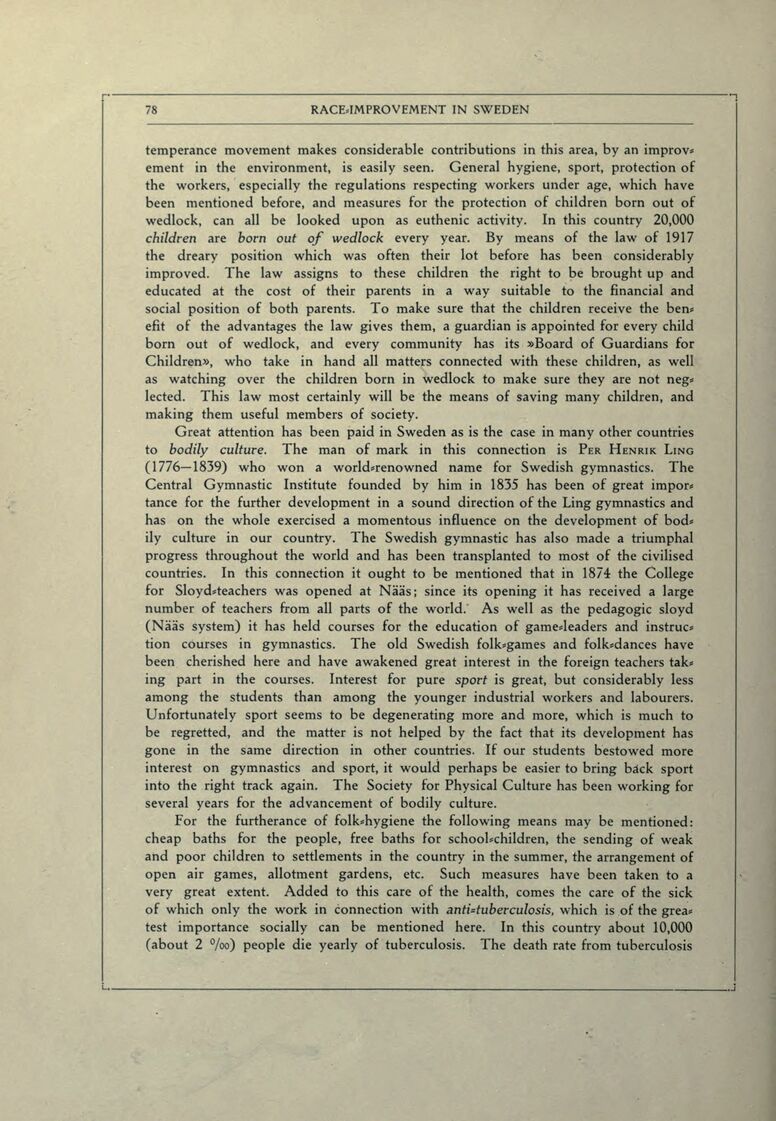
Full resolution (JPEG) - On this page / på denna sida - Part I - Professor J. Vilhelm Hultkrantz, Uppsala and Doctor Emanuel Bergman, Uppsala, The Struggle for Race-improvement in Sweden

<< prev. page << föreg. sida << >> nästa sida >> next page >>
Below is the raw OCR text
from the above scanned image.
Do you see an error? Proofread the page now!
Här nedan syns maskintolkade texten från faksimilbilden ovan.
Ser du något fel? Korrekturläs sidan nu!
This page has never been proofread. / Denna sida har aldrig korrekturlästs.
temperance movement makes considerable contributions in this area, by an improv*
ement in the environment, is easily seen. General hygiene, sport, protection of
the workers, especially the regulations respecting workers under age, which have
been mentioned before, and measures for the protection of children born out of
wedlock, can all be looked upon as euthenic activity. In this country 20,000
children are born out of wedlock every year. By means of the law of 1917
the dreary position which was often their lot before has been considerably
improved. The law assigns to these children the right to be brought up and
educated at the cost of their parents in a way suitable to the financial and
social position of both parents. To make sure that the children receive the ben*
efit of the advantages the law gives them, a guardian is appointed for every child
born out of wedlock, and every community has its »Board of Guardians for
Children», who take in hånd all matters connected with these children, as well
as watching over the children born in wedlock to make sure they are not neg*
leeted. This law most certainly will be the means of saving many children, and
making them useful members of society.
Great attention has been paid in Sweden as is the case in many other countries
to bodily culture. The man of mark in this connection is Per Henrik Ling
(1776—1839) who won a world*renowned name for Swedish gymnastics. The
Central Gymnastic Institute founded by him in 1835 has been of great impor*
tance for the further development in a sound direction of the Ling gymnastics and
has on the whole exercised a momentous influence on the development of bod*
ily culture in our country. The Swedish gymnastic has also made a triumphal
progress throughout the world and has been transplanted to most of the civilised
countries. In this connection it ought to be mentioned that in 1874 the College
for Sloyd*teachers was opened at Nääs; since its opening it has received a large
number of teachers from all parts of the world. As well as the pedagogic sloyd
(Nääs system) it has held courses for the education of game*leaders and instruc*
tion courses in gymnastics. The old Swedish folk*games and folk*dances have
been cherished here and have awakened great interest in the foreign teachers tak*
ing part in the courses. Interest for pure sport is great, but considerably less
among the students than among the younger industrial workers and labourers.
Unfortunately sport seems to be degenerating more and more, which is mueh to
be regretted, and the matter is not helped by the faet that its development has
gone in the same direction in other countries. If our students bestowed more
interest on gymnastics and sport, it would perhaps be easier to bring bäck sport
into the right track again. The Society for Physical Culture has been working for
several years for the advancement of bodily culture.
For the furtherance of folk*hygiene the following means may be mentioned:
cheap baths for the people, free baths for school*children, the sending of weak
and poor children to settlements in the country in the summer, the arrangement of
open air games, allotment gardens, etc. Such measures have been taken to a
very great extent. Added to this care of the health, comes the care of the sick
of which only the work in connection with anti=tuberculosis, which is of the grea*
test importance socially can be mentioned here. In this country about 10,000
(about 2 %o) people die yearly of tuberculosis. The death rate from tuberculosis
<< prev. page << föreg. sida << >> nästa sida >> next page >>